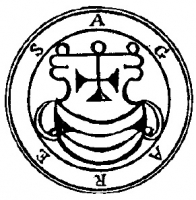The Hand of Glory
The Hand of Glory is a grisly item related to a once wide held belief in the magical power of human remains, especially those of the executed. The Hand of Glory is essentially a severed hand from a gibbeted/hanged/executed criminal (the more notorious the greater its supposed potency) that was dried in the Sun after pickling and treatment with various noxious materials. The hand was then enclosed around a candle – preferably made with the fat of a hanged man – or the fingers were turned into macabre wicks. It was believed that this gruesome brand would confer invisibility to its owner, render the occupants of a household into a deep sleep, and open locked doors. As such the item was highly prized by burglars and other criminals, an essential part of burglars paraphernalia form the early 18th century.
![www.badobadop.co.uk [CC BY-SA 4.0 (https://creativecommons.org/licenses/by-sa/4.0)], from Wikimedia Commons](http://www.mysteriousbritain.co.uk/wp/wp-content/uploads/2008/08/Hand_of_Glory-300x143.jpg)
This hand was discovered in the early 20th century on the roof wallpate of Hawthorn Cottage in Danby. It is thought that it might have originated from Gibbet Howe, Castleton and been in use as late as 1820.
The belief in the power of the hand of glory has its root in sympathetic magic (a belief dating far back into mankind’s dark history).
It was thought that the burning of the hand would send its victims into a death like slumber, a thin reflection of the fate suffered by the hands previous unfortunate owner. According to Funk and Wagnall’s Standard Dictionary of Folklore and Mythology, The Hand of Glory is related to the French Main de gloire (Mandragore) or Mandrake and its relative superstitions. The Mandrake was thought to grow from the seed of a hanged man, and the potent magical properties were attributed to this and its association with the gallows. A similar belief as the Hand of Glory is prevalent in other countries although sometimes related to other body parts no-less horrific. In Mexico for instance the left forearm of a woman who had died in first childbirth was said to confer the same power to its owner. These grisly beliefs associated with the dead were widespread before the age of reason, although the hand of glory is associated with the 18th and early 19th century.
There are many other superstitions relating to body parts, and blood of the executed. The blood of executed men was thought to have especially potent magical qualities. There was a rush of people trying to dip their rags into the spilled blood of Charles the I for example.
Rhymes and chants were often used to make the hand more effective the most common being:
Let those who rest more deeply sleep,
Let those awake their vigils keep,
Oh, hand of glory, shed thy light,
Direct us to our spoil tonight.
This has a few variations but the general jist of the rhyme is very similar.
There are number of Hands of Glory still in existence, proving that the belief was certainly taken literally by some, even if they are now no more than grisly curiosities; a hand of Glory was once on display at Whitby Museum. There are also a number of folk stories associated with the hand, many in the North of England where the belief seems to have been most prevalent.




Recent Comments